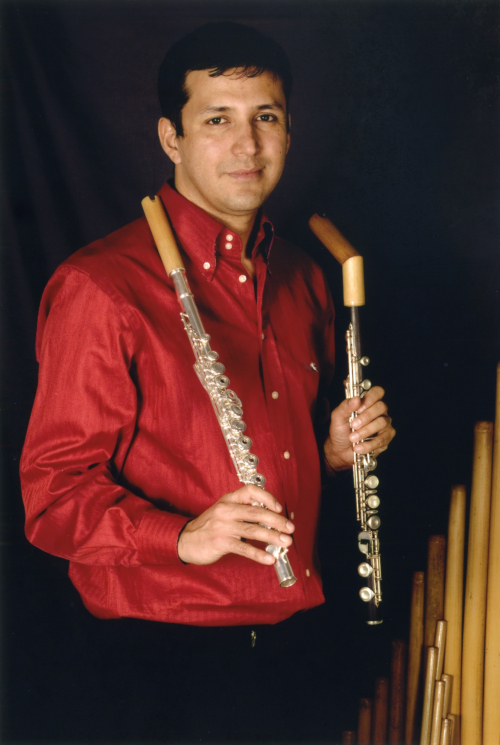A Transcendental Symphony of Unity
Human Rights Education and Music/Music Education
Research Team on the Didactics of Arts and Movement (DAM)
Faculty of Educational Sciences, University of Geneva, Switzerland
UNESCO International Dance Council, Paris
Sony Music Recording Artist, Japan
This article presents research in human rights education, based on my life experiences of a multifaceted integration of ancient Eastern and modern Western cultures in the fields of music education, composition, and performance on musical instruments. For the last thirty-five years I have been deeply involved in the mentioned music fields by living and studying in Latin America, Japan, India, and Europe under their topmost masters in these music cultures.
The teachings from the first three music cultures are based on oral traditions (observation, listening, and imitation). I have successfully established original links between these oral traditions and the written traditions of western European music culture. Human rights education contributes attitudes and behaviors to defend and transmit dignity, respect, justice, democracy, and rule of law by ensuring, protecting, and guiding every individual’s right to the most essential needs for human existence (Talesra, Pancholy, Lal Nagda, 2002).
According to the mentioned oral traditions, the sound of music is considered the most powerful tool to elevate human consciousness and access our inner state of unity, equanimity, and equality (De La Calle, 2018). This inner state provides the powerful vision that every living being is equal to ourselves, as a part of a unique family (Resnick, 2016). Individuals with this inner state are kind-hearted to all human beings (predisposed to forgive) and dedicated to others’ welfare, because they feel satisfied within by a peaceful and joyful inner spirit (Beck, 2006). In this way, an individual is able to love all sentient beings, not just human beings, as one loves oneself (Resnick). This vision of life with the mentioned outcomes would also bring amazing environmental benefits that contribute to the promotion of the achievement of the United Nations’ 17 Sustainable Development goals in the 2030 Agenda for Sustainable Development.
Music as a wonderful tool for unity in diversity
Under the guidance of qualified artists who have access to the inner state of unity/equality, music becomes a wonderful, unique tool to elevate people’s consciousness to this vision, because it is done naturally and very joyfully. By learning, practicing, and performing regularly on musical instruments in a band (such as a community orchestra), people can be consciously trained to compose and perform as a sincere offering of unconditional love to the original source of everything. Inspired offerings of unconditional love transform disunity into unity by dissolving dualities such as friendship and enmity or love and hate (Resnick).
Such musical activities contribute to the development of social-emotional intelligence on multiple levels. They nurture an individual’s internal harmony and emotional unity by making the inner self aware of its full potential, through feelings of intense joy, peace, and prosperity (Biela, 2014). Much like Plato, Aristotle believed that music helped students understand and order their emotions, because the flow of melody and rhythm is a metaphor for emotional flux (Woerther, 2008). Therefore, Aristotle claimed that learning to play a musical instrument is essential to the development of our character (Ford, 2004). And character development is a foundation to understand the importance of human rights education. First, the musical interaction between the members of an orchestra develops a sense of community and socialization by simultaneously activating seven kinds of learning in a child (the kinesthetic, visual, aural, verbal, emotional intelligence, logic/brain power/IQ, intrapersonal/creativity/composition/self-expression). Second, the harmonious social interaction and musical communication between the members of a musical community aid in developing human and spiritual values (Stobart and Cross, 2000).
Some of the human values that are developed are a respect for oneself and others, obedience, perseverance, patience, loyalty, responsibility, solidarity, equanimity, honesty, identifying and managing one’s emotions by understanding how one’s emotions relate to the other members. A few of the spiritual values that are developed are gratitude, modesty, empathy, generosity, and unconditional love.
Integrating Western and Eastern traditions
The object of love is beauty, says Socrates in the Symposium (Rosen, 1987). Describing his famous “stairs of love,” Socrates says that initially we desire physical beauty, then progress toward moral and mental beauty, followed by beauty of laws and institutions, then beauty of philosophical understanding, and finally we desire beauty itself, the form of beauty, an eternal, unfading beauty. The Noh theater from Japan and the Upanisads from ancient India describe a similar ascent of human consciousness: awareness on the physical level of food (anna), then vital air (prāna), and mind (manas), intellect (vijñāna), and everlasting joy (ānanda) (Gupta, 2009). The inner state of everlasting, intense joy in unity/equality is the essential emotional quality of music that creates a bridge between (1) metaphysics (as the study of the ultimate reality) and aesthetics (beauty and love) (Beck). Music is not just an aesthetic pleasure but a bridge from the material to the spiritual.
Through my life’s cross-cultural translation across music cultures in Eastern and Western traditions, I have developed an innovative approach in teaching/learning processes (and music contents), along with an artistic expression that transcends historical issues. It portrays an essential advancement of human consciousness from the gross to the subtle, from the material to the spiritual, and from the temporal to the eternal (Gupta). Through this integrative approach, it is demonstrated that art is a force with the power to express the individual’s deep hankering for happiness, rooted in aesthetics. Therefore, aesthetics is at the heart of human existence and is the nature of the ultimate reality of life, the original source of our inner state of unity/equality.
I have let you understand partially (by describing and explaining in words) the unique power of music to elevate the human consciousness and access an inner state of unity/equality. A holistic understanding and realization of this inner state, which represents the spirit and message of human rights education will be more fully accomplished by listening to a piece of music that was composed and performed in this way (Dewey, 2008).
(1) Metaphysics is related to the individual’s behavior within a permanent reality (spirituality) beyond the physical world, which is time bound and impermanent.
Here is a visual/aural music sample that I composed and performed, released by Sony Music, Japan (2021), which presents the multicultural approach of musical elements from Eastern and Western traditions
From Latin America, Europe, Japan, and India:
https://youtu.be/2YY1apYi-Q0?si=a-5ORKavlJR5_AHO
Conclusion
Our task is to elevate people’s consciousness to the point of their accessing an inner state of unity/equality on a spiritual level, which satisfies their hankering for truth, happiness, and peace and makes them aware of and capable of realizing their full potential. We accomplish this using music/music education. To be human means more than survival on a material level. The essence of humanity is in the connection that we share with all beings on the spiritual level. To truly achieve access to and protection through human rights education, we need to address both material and spiritual development (Singh, 2021).
As stated before, music is the most powerful and unique tool to elevate people’s consciousness when it is performed and guided by artists who are qualified to access this inner state of unity on the spiritual level. When our hearts are deeply touched by these sorts of artists, we become very much interested in what they think or feel or want to say. The message of human rights education urgently needs to be endorsed and carried by these transcendental artists, who will educate people to sing and perform in a transcendental symphony of unity.
For this to be accomplished, since 2016 I have developed and integrated this form of music education in primary and secondary schools in Geneva, Switzerland, with the creation and performances of orchestras and operas. The International School of Geneva, the world’s oldest international school, adopted and integrated this way of teaching and performing music with great results for the youth and their character development. This educational music program has helped them understand the importance of the daily cultivation of the needed message of human rights education from the perspective I have described.
References
Beck, Guy L. (2006): Sacred Sound: Experiencing Music in World Religions. New Delhi: Motilal Banarsidass Publishers.
Biela, Adam. (2014): Paradigm of Unity as a Prospect for Research and Treatment in Psychology. J. Perspect. Econ. Political Soc. Integr; 19:207–27.
De La Calle, Luis (2018): Afghanistan, Trying Peace Against All Odds.
UN Special, the Official Magazine of International Civil Servants N° 778, 38-39.
Dewey, John (2008): El arte como experiencia. Barcelona: Ediciones Paidós Ibérica.
Ford, A. (2004): “Catharsis: The Power of Music in Aristotle’s Politics” in P. Murray and P. Wilson (eds.), Music and the Muses: The Culture of ‘Mousikē’ in the Classical Athenian City. Oxford: Oxford University Press, 309–36.
Gupta, Ravi: Sonidos Sagrados: la Musica como Revelación en la Tradicion Vaishnava. En: Solaris, Revista Intercultural No. 3, 2009, 85–90.
Singh, Kushmika (Editor, MSc, MPhil) in discussion on 06/05/2021 (personal communication).
Resnick, Howard (2016): Guia para Comprender la Bhagavad-gita con traduccion literal. Buenos Aires: KW Editorial.
Rosen, Stanley (1987): Plato’s Symposium. Second edition. New Haven: Yale University Press.
Stobart, Henry and Cross, Ian (2000): The Andean Anacrusis?Rhythmic Structure and Perception in Easter Songs of Northern Potosi, Bolivia. British Journal of Ethnomusicology, Vol 9, (2), 63–92.
Talesra, Hemlata; Pancholy, Malini; Lal Nagda, Mangi (eds.) (2002): Human Rights Education: A Global Perspective. New Delhi: Daya Books.
Woerther, F. (2008): Music and the Education of the Soul in Plato and Aristotle: Homoeopathy and the Formation of Character. Classical Quarterly 58.1, 89–103.

